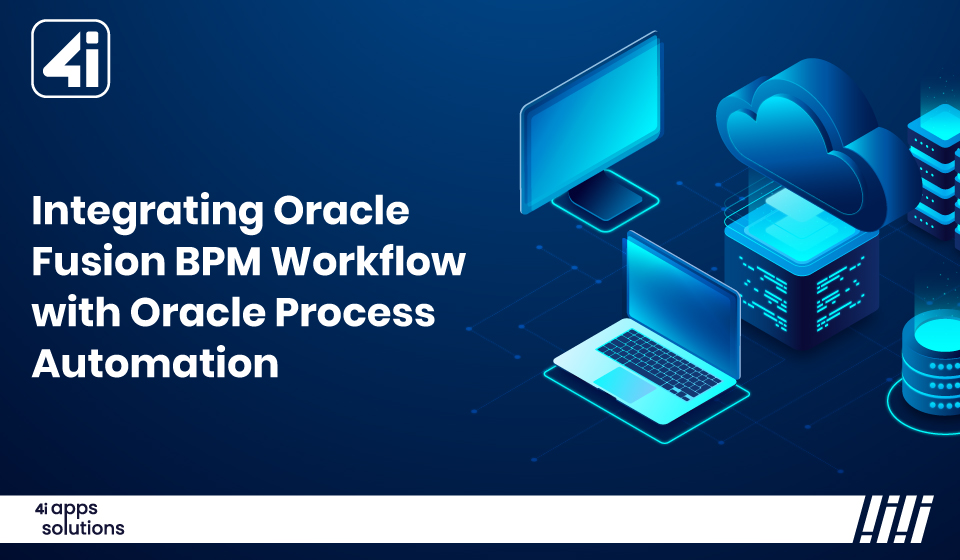Integrating Oracle Fusion BPM Workflow with Oracle Process Automation
Introduction
Imagine a workplace where managing tasks feels like juggling two separate systems, each with its own interface and quirks. For organizations using Oracle Fusion BPM (Business Process Management) and Oracle Process Automation (OPA), this is a common challenge. The lack of integration between these platforms creates a fragmented user experience, forcing employees to toggle between systems to complete their tasks. This case study explores a solution to unify Oracle Fusion BPM and OPA workflows, streamlining processes, boosting productivity, and delivering a seamless user experience. By leveraging APIs, data merging, and a custom interface, we’ll demonstrate how to consolidate task management into a single, intuitive page.
In this post, we’ll uncover how integrating these systems can transform workflow efficiency, saving time and reducing frustration for users across the board.
Problem Statement
The core issue lies in the disconnected nature of Oracle Fusion BPM and Oracle Process Automation workflows. Currently, users access Fusion BPM tasks via a bell icon on the Fusion BPM page, which notifies them of pending actions. In contrast, OPA workflows are relegated to a separate custom page. This setup requires users to switch between interfaces, leading to:
- Fragmented User Experience: Navigating multiple platforms disrupts workflow continuity.
- Reduced Productivity: Time spent toggling between systems detracts from task completion.
- Lower User Satisfaction: A clunky interface increases frustration and hampers engagement.
This lack of integration complicates task management, making it harder for users to stay on top of deadlines and priorities across both systems.
Objective
The goal is to create a unified platform where users can view and act on tasks from both Oracle Fusion BPM and Oracle Process Automation seamlessly. By integrating APIs from both systems, we aim to:
- Retrieve task data from Fusion BPM and OPA.
- Merge this data into a single JSON array.
- Render the combined data on a custom page, offering a centralized hub for task management.
This unified view will simplify workflows, enhance decision-making, and improve operational efficiency.
Approach
Understanding the APIs
Both Oracle Fusion BPM and Oracle Process Automation provide robust REST APIs to access workflow data, including task details, deadlines, and available actions. These APIs serve as the backbone of the integration, enabling programmatic retrieval of critical information. For example:
- Fusion BPM API: Provides endpoints to fetch active tasks, task metadata (e.g., task ID, name, priority), and due dates.
- OPA API: Offers similar functionality, delivering workflow data such as task descriptions and status.
Understanding the structure and authentication requirements of these APIs (e.g., OAuth2 for secure access) is the first step toward building a cohesive solution.
Merging Data from Two Sources
To create a unified task list, we need to aggregate data from both APIs into a single JSON array. This involves:
- Calling Oracle Fusion BPM API: Retrieve workflow data, including task names, IDs, due dates, and statuses.
- Calling Oracle Process Automation API: Fetch similar data for OPA workflows.
- Merging the Data: Combine the datasets into a single JSON array, ensuring consistency in field names and formats (e.g., standardizing “due_date” vs. “deadline”).
- Standardizing the Format: Normalize attributes to ensure seamless rendering on the custom page.
For instance, a merged JSON array might look like this:
json
Copy
[
{
“task_id”: “BPM_001”,
“source”: “Fusion BPM”,
“name”: “Approve Budget”,
“due_date”: “2025-05-20”,
“priority”: “High”
},
{
“task_id”: “OPA_002”,
“source”: “OPA”,
“name”: “Review Contract”,
“due_date”: “2025-05-18”,
“priority”: “Medium”
}
]
This unified structure ensures that tasks from both systems are presented consistently, regardless of their origin.
Custom Page Creation
With the merged JSON array in hand, the next step is to design a custom page that serves as the central hub for task management. This page should:
- Display a Unified Task List: Present tasks from both Fusion BPM and OPA in a clear, tabular format.
- Enable Direct Actions: Allow users to complete, update, or redirect tasks without leaving the page.
- Support Task Management Features: Include filtering (e.g., by due date or priority), sorting, and search functionality.
- Provide Real-Time Updates: Reflect changes in task status or new tasks instantly.
The page could resemble a dashboard with interactive elements, such as buttons for task completion or links to detailed workflows in the respective systems.
Handling User Actions
To make the custom page fully functional, it must support user interactions, including:
- Completing Tasks: Users can mark tasks as done, triggering updates in the respective system via API calls.
- Redirecting to Workflows: For complex actions, users can navigate to the original Fusion BPM or OPA interface.
- Updating Task Details: Allow changes to task status, priority, or notes directly from the page.
- Real-Time Notifications: Alert users to new tasks or approaching deadlines using in-page notifications or email integration.
These features ensure that the custom page is not just a passive display but an active tool for workflow management.
Testing and Validation
Rigorous testing is essential to confirm the integration’s reliability and usability. Key areas to validate include:
- Data Accuracy: Ensure the merged JSON array correctly reflects tasks from both systems.
- UI Functionality: Verify that tasks display properly and support all intended actions.
- System Interoperability: Confirm that actions taken on the custom page sync correctly with Fusion BPM and OPA.
- User Experience: Conduct user testing to ensure the interface is intuitive and efficient.
Testing should simulate real-world scenarios, such as high task volumes or concurrent user actions, to guarantee scalability.
Benefits
This integration delivers tangible advantages for organizations:
- Streamlined Workflow: A single interface eliminates the need to switch between systems, saving time and reducing errors.
- Improved Productivity: Users can complete tasks faster, with all relevant information at their fingertips.
- Increased User Satisfaction: A cohesive, user-friendly interface boosts engagement and reduces frustration.
- Reduced Complexity: Consolidating task management simplifies processes, making it easier to meet deadlines.
For example, a finance team using this solution could approve budgets (Fusion BPM) and review contracts (OPA) from the same page, cutting down on administrative overhead.
Technical Details
Integrating an Oracle SaaS Application with Oracle PaaS
The integration leverages federated trust between Oracle Fusion Applications Cloud Service (SaaS) and Oracle PaaS, facilitated by Oracle Identity Cloud Service (IDCS). This setup enables:
- Federated Single Sign-On (SSO): Secured via SAML-based authentication for seamless user access.
- OAuth2 Configuration: Protects REST API calls with token-based authentication, ensuring secure data retrieval.
- Role Synchronization: Aligns user roles and permissions across both platforms.
Architecture Options
- Fusion Applications as Identity Provider:
- Users and roles are managed in Fusion Applications and synced to IDCS.
- IDCS handles user and group management for PaaS applications.
- Ideal for organizations centralized around Fusion Applications.
- IDCS as Identity Provider:
- Fusion Applications act as a service provider, with IDCS managing identities.
- The Fusion ESS Sync Job synchronizes roles and memberships.
- Suitable for PaaS-centric setups.


Required Services and Roles
| Service Name | Role | Required To |
| Oracle Fusion Applications Cloud Service | Application Diagnostics Administrator, Application Implementation Consultant, IT Security Manager | Configure endpoints and set up the ESS Sync Job in Fusion Applications. |
| Oracle Identity Cloud Service | Identity Domain Administrator | Configure federated SSO, OAuth, and user/role synchronization in IDCS. |
Configuring Oracle Identity Cloud Service
To secure API access, download the IDCS Tenant Signing Certificate:
- In the IDCS console, navigate to the Settings tab and enable Access Signing Certificate.
- Download certificate data from https://<IDCS_HOST>/admin/v1/SigningCert/jwk, which includes two certificates.
- Create two files (idcs.cert and idcs_ca.cert) by copying each certificate’s data, including the —–BEGIN CERTIFICATE—– and —–END CERTIFICATE—– headers.
- Retrieve the issuer name and token endpoint from https://<IDCS_HOST>/.well-known/idcs-configuration.
These steps, provided by the Oracle team, ensure secure API authentication using OAuth2 tokens.
API Integration
Both systems offer REST APIs with endpoints for task retrieval:
- Fusion BPM: GET /bpm/api/tasks retrieves active tasks, including metadata like task ID, name, and due date.
- OPA: GET /opa/api/workflows fetches workflow data with similar attributes.
Authentication is handled via OAuth2 tokens obtained through IDCS, ensuring secure access.
JSON Merging Logic
The merging logic standardizes key fields (e.g., task ID, name, due date) into a unified JSON structure. A sample merging script might look like this:
javascript
Copy
const bpmTasks = await fetchBpmTasks(); // API call to Fusion BPM
const opaTasks = await fetchOpaTasks(); // API call to OPA
const mergedTasks = [
…bpmTasks.map(task => ({
task_id: task.id,
source: “Fusion BPM”,
name: task.title,
due_date: task.deadline,
priority: task.priority
})),
…opaTasks.map(task => ({
task_id: task.taskId,
source: “OPA”,
name: task.name,
due_date: task.dueDate,
priority: task.urgency
}))
];
This script ensures consistent field names and formats, enabling seamless rendering on the custom page.
Conclusion
Integrating Oracle Fusion BPM with Oracle Process Automation transforms a fragmented workflow into a cohesive, efficient process. By leveraging APIs to merge task data, securing access with OAuth2, and building a custom page for unified task management, organizations can streamline operations and enhance user satisfaction. This solution empowers teams to focus on their work, not on navigating multiple systems, leading to faster decision-making and a more productive work environment.
Key Takeaway: With the right integration strategy, Oracle Fusion BPM and OPA can work as a single, powerful tool for workflow management, simplifying tasks and driving operational excellence.
This content was enriched with additional technical details and examples by referring to Oracle’s documentation and general integration best practices available on the web.
About the Author
Sathish Kumar B is a Senior Practice Manager at OTEC, specializing in Oracle Cloud Applications. With years of experience in Oracle’s Fusion BPM and Process Automation platforms, Sathish leads integration projects that drive operational excellence and streamline workflow efficiency. He is passionate about leveraging cloud technologies to solve complex business challenges and enhance user experiences through seamless system integrations.







